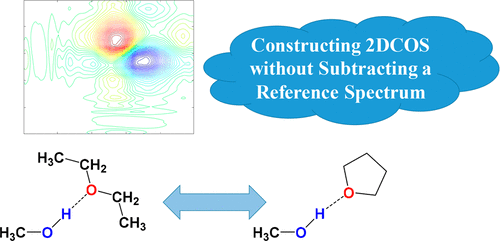当前位置:
X-MOL 学术
›
J. Phys. Chem. A
›
论文详情
Our official English website, www.x-mol.net, welcomes your feedback! (Note: you will need to create a separate account there.)
Novel Method of Constructing Two-Dimensional Correlation Spectroscopy without Subtracting a Reference Spectrum
The Journal of Physical Chemistry A ( IF 2.9 ) Pub Date : 2018-01-16 00:00:00 , DOI: 10.1021/acs.jpca.7b10710 Anqi He 1, 2, 3 , Yiwei Zeng 1 , Xiaoyan Kang 4 , Shigeaki Morita 5 , Yizhuang Xu 1, 2 , Isao Noda 1, 6 , Yukihiro Ozaki 1, 4 , Jinguang Wu 1
The Journal of Physical Chemistry A ( IF 2.9 ) Pub Date : 2018-01-16 00:00:00 , DOI: 10.1021/acs.jpca.7b10710 Anqi He 1, 2, 3 , Yiwei Zeng 1 , Xiaoyan Kang 4 , Shigeaki Morita 5 , Yizhuang Xu 1, 2 , Isao Noda 1, 6 , Yukihiro Ozaki 1, 4 , Jinguang Wu 1
Affiliation

|
In this study, we propose a new approach to generate two-dimension spectra to enhance the intensity of cross peaks relevant to intermolecular interaction. We investigate intermolecular interaction between two solutes (denoted as P and Q, where P has a characteristic peak at XP) dissolved in the same solvent via the near diagonal cross peaks around the coordinate (XP, XP) in a two-dimensional (2D) asynchronous spectrum of generalized spectroscopy. Because of physical constrains in many cases, the variation ranges of the initial concentrations of P or Q must be kept very narrow, leading to very weak cross peak intensities. The weak cross peaks vulnerable to noise bring about difficulty in the investigation of subtle intermolecular interaction. Herein, we propose a new of way constructing a 2D asynchronous spectrum without the subtraction of the average spectrum often used as a reference spectrum. Mathematical analysis and computer simulation demonstrate that the near diagonal cross peaks around the coordinate (XP, XP) in the 2D asynchronous spectrum using the new approach possess two characteristics: (1) they can still reflect an intermolecular interaction reliably; 2) the absolute intensities of the cross peaks are significantly stronger than those generated by the conventional method. We incorporate the novel method with the DAOSD (double asynchronous orthogonal sample design scheme) approach and applied the modified DAOSD approach to study hydrogen bonding behavior in diethyl either/methanol/THF system. The new approach made the weak cross peaks, which are not observable in 2D asynchronous spectrum generated using conventional approach, become observable. The appearance of the cross peak demonstrate that When a small amount of THF is introduced into diethyl solution containing low amount of methanol, THF breaks the methanol–diethyl ether complex and forms methanol-THF complex via new hydrogen bond. This process takes place in spite of the fact that the content of diethyl ether is overwhelmingly larger than that of THF. The above result demonstrates that the new approach described in this article is applicable to enhance intensity of cross peaks in real chemical systems.
中文翻译:

在不减去参考光谱的情况下构造二维相关光谱的新方法
在这项研究中,我们提出了一种生成二维光谱的新方法,以增强与分子间相互作用相关的交叉峰的强度。我们通过坐标(X P,X P)附近的对角交叉峰研究了溶解在相同溶剂中的两种溶质(分别表示为P和Q,其中P在X P处有一个特征峰)之间的分子间相互作用。)在二维(2D)异步光谱的广义光谱中。在许多情况下,由于物理限制,P或Q的初始浓度的变化范围必须保持非常狭窄,从而导致交叉峰强度非常弱。易受噪声干扰的弱交叉峰给细微的分子间相互作用的研究带来了困难。在此,我们提出了一种新的构造二维异步频谱的方法,该方法无需减去经常用作参考频谱的平均频谱。数学分析和计算机仿真表明,坐标(X P,X P)在使用新方法的2D异步频谱中具有两个特征:(1)它们仍可以可靠地反映分子间的相互作用;2)交叉峰的绝对强度明显强于常规方法产生的强度。我们将新方法与DAOSD(双重异步正交样本设计方案)方法结合起来,并应用改进的DAOSD方法来研究二乙基正己烷/甲醇/ THF体系中的氢键行为。新方法使可观察到的弱交叉峰(在使用常规方法生成的2D异步频谱中无法观察到)成为可能。交叉峰的出现表明,当将少量THF引入到含有少量甲醇的二乙基溶液中时,THF破坏甲醇-乙醚络合物,并通过新的氢键形成甲醇-THF络合物。尽管二乙醚的含量远大于THF的含量,但仍会发生此过程。以上结果表明,本文介绍的新方法适用于增强实际化学系统中交叉峰的强度。
更新日期:2018-01-16
中文翻译:

在不减去参考光谱的情况下构造二维相关光谱的新方法
在这项研究中,我们提出了一种生成二维光谱的新方法,以增强与分子间相互作用相关的交叉峰的强度。我们通过坐标(X P,X P)附近的对角交叉峰研究了溶解在相同溶剂中的两种溶质(分别表示为P和Q,其中P在X P处有一个特征峰)之间的分子间相互作用。)在二维(2D)异步光谱的广义光谱中。在许多情况下,由于物理限制,P或Q的初始浓度的变化范围必须保持非常狭窄,从而导致交叉峰强度非常弱。易受噪声干扰的弱交叉峰给细微的分子间相互作用的研究带来了困难。在此,我们提出了一种新的构造二维异步频谱的方法,该方法无需减去经常用作参考频谱的平均频谱。数学分析和计算机仿真表明,坐标(X P,X P)在使用新方法的2D异步频谱中具有两个特征:(1)它们仍可以可靠地反映分子间的相互作用;2)交叉峰的绝对强度明显强于常规方法产生的强度。我们将新方法与DAOSD(双重异步正交样本设计方案)方法结合起来,并应用改进的DAOSD方法来研究二乙基正己烷/甲醇/ THF体系中的氢键行为。新方法使可观察到的弱交叉峰(在使用常规方法生成的2D异步频谱中无法观察到)成为可能。交叉峰的出现表明,当将少量THF引入到含有少量甲醇的二乙基溶液中时,THF破坏甲醇-乙醚络合物,并通过新的氢键形成甲醇-THF络合物。尽管二乙醚的含量远大于THF的含量,但仍会发生此过程。以上结果表明,本文介绍的新方法适用于增强实际化学系统中交叉峰的强度。



























 京公网安备 11010802027423号
京公网安备 11010802027423号